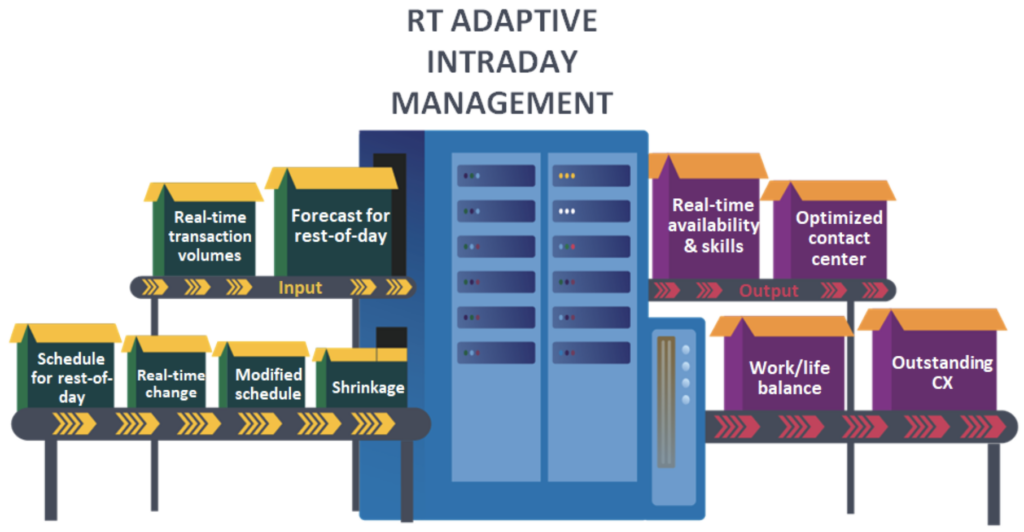Real-Time Adaptive Intraday Management Saves the Day
April 2024
Workforce management (WFM) solutions are changing for the better. Vendors are delivering enhancements and innovations with the potential to greatly improve the effectiveness of many aspects of these applications. However, when all is said and done, today’s WFM solutions still have the same two core objectives they had when first introduced over 50 years ago: forecasting the volume of work expected to arrive in a given time frame and scheduling the appropriate resources to get the work done within a service level. The difference is that customer expectations, employee requirements, and contact center dynamics are much more sophisticated and complex than in the past, driving the need for intelligent, adaptable, automated, and real-time-centric WFM capabilities.
The Forecasting Challenge
When it comes to forecasting, it’s challenging to plan for the unexpected. WFM solutions are good at finding trends in historical interaction data to generate projections. And these applications are also designed to allow administrators to make changes to address exceptions. However, it’s still difficult (if not impossible) to accurately plan for unanticipated severe weather events or other “acts of God” that significantly alter the volume of work and availability of resources. Anomalies can be caused by any number of unforeseen scenarios including a much higher than planned response rate to a marketing campaign or the surf being up along the coast, increasing the shrinkage rate.
Despite the challenges, companies still need to forecast; otherwise, they won’t know how many employees/agents to hire, train, and schedule to handle upcoming work volumes. What this means is a historically based forecast should only be considered a starting point in the scheduling process, with the understanding that volumes and resources are likely to change. Therefore, WFM solutions need to adapt their forecasts and schedules in real-time to respond to changing dynamics. While doing so, they must also consider the impact of these modifications on the remainder of the day. However, traditional WFM forecasting tools are not a good fit for responding to intraday modifications.
Old vs. New Intraday Management
This is where real-time adaptive intraday management comes in. DMG’s concept of a next-gen intraday management module is a greatly enhanced version of previous intraday management capabilities that were created as add-ons to most (if not all) WFM solutions. Established intraday management modules enable WFM administrators or supervisors to identify necessary schedule changes during a business day, but their results are generally not in real time, and the suggested changes must be applied manually. As a result, in many cases, even when an intraday management module is run on a timely basis, its recommendations are often obsolete before they can put into action. Clearly, something must change for contact centers to cost-effectively meet their service level commitments while not forcing employees to constantly change their personal schedules without advance notice.
The new real-time adaptive intraday management modules are intended to do the following:
- Receive and respond to real-time changes in volumes and agent resources on an ongoing basis throughout each business day without manual intervention by a WFM administrator/supervisor
- As each new forecast and schedule is run, reforecast the remainder of the day to minimize the total number of schedule changes needed
- Apply artificial intelligence technologies to smooth out intraday scheduling changes
- Fully automate the schedule change process by applying pre-established rules to eliminate the need for WFM administrators/supervisors to be involved
- Invite agents to utilize self-service capabilities to change their schedules throughout the day
- Feed the final schedule for each day and relevant metadata back into the core forecasting and scheduling engines.

Source: DMG Consulting LLC, April 2024
For this to work, contact centers will need to create intraday scheduling rules that agents find fair and acceptable, as well as provide incentives for active participation. For example, the solution should award points to agents who accept last-minute schedule changes, volunteer to stay and work some hard-to-fill hours, or provide substantial flexibility by being readily available to work from home in short bursts when volumes spike, etc. Points can be used in exchange for future scheduling privileges or in gamification applications for tangible and intangible rewards and recognition. Lastly, it’s essential for contact center leaders to be transparent about what rules are implemented and how the system works to eliminate complaints about unfairness.
